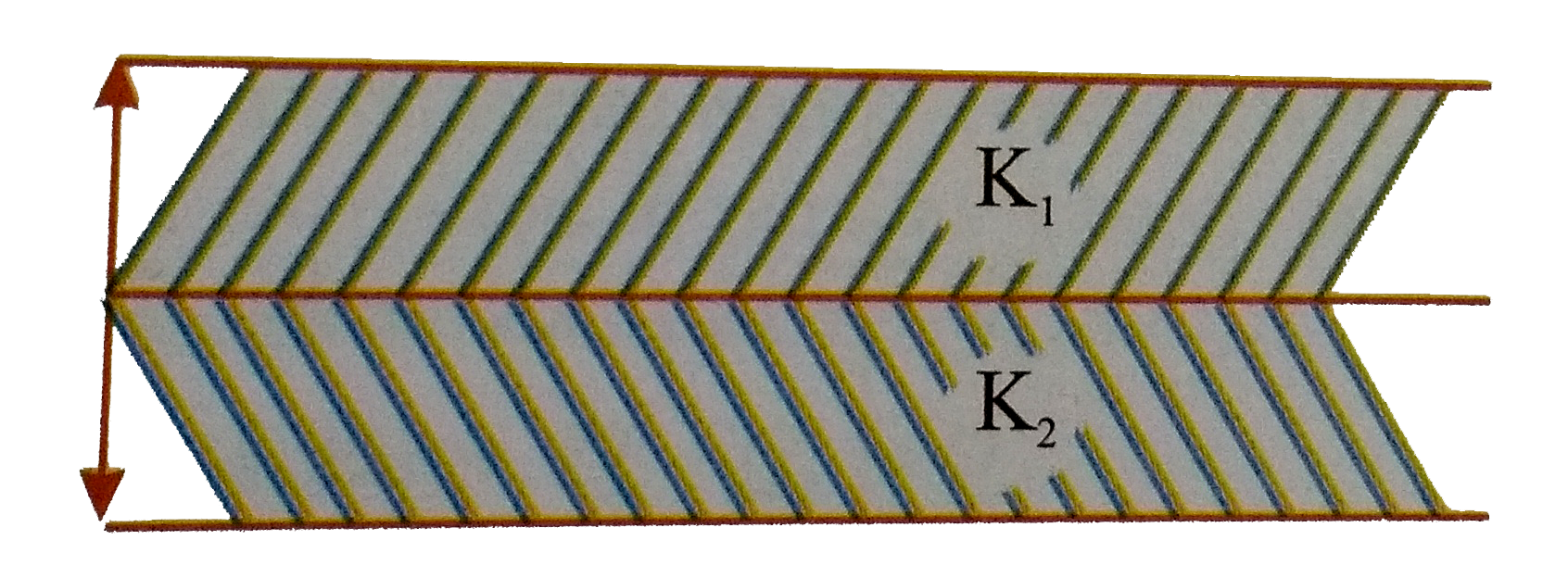Between the plates of a parallel plate condenser, a plate of thickness t1 and dielectric constant k1 is placed. In the rest of the space, there is another plate of thickness t2 and dielectric constant k2. The potential difference across the condenser will be
QAε0(t1k1+t2k2)
ε0QA(t1k1+t2k2)
QAε0(k1t1+k2t2)
ε0QA(k1t1+k2t2)
The correct Answer is:A
To find the potential difference across a parallel plate capacitor with two dielectric slabs inserted, we can follow these steps:
Step 1: Understand the Configuration
We have a parallel plate capacitor with two dielectric slabs:
- The first slab has thickness t1 and dielectric constant k1.
- The second slab has thickness t2 and dielectric constant k2.
Step 2: Model the Capacitor
The two dielectric slabs can be treated as two capacitors in series:
- Capacitor 1 (with dielectric k1 and thickness t1)
- Capacitor 2 (with dielectric k2 and thickness t2)
Step 3: Calculate Individual Capacitances
The capacitance of a capacitor filled with a dielectric is given by:
C=kϵ0Ad
where k is the dielectric constant, ϵ0 is the permittivity of free space, A is the area of the plates, and d is the distance between the plates.
For the two capacitors:
- For Capacitor 1:
C1=k1ϵ0At1
- For Capacitor 2:
C2=k2ϵ0At2
Step 4: Find the Equivalent Capacitance
Since the two capacitors are in series, the equivalent capacitance Ceq is given by:
1Ceq=1C1+1C2
Substituting the expressions for C1 and C2:
1Ceq=t1k1ϵ0A+t2k2ϵ0A
This simplifies to:
1Ceq=1ϵ0A(t1k1+t2k2)
Thus, the equivalent capacitance is:
Ceq=ϵ0At1k1+t2k2
Step 5: Calculate the Potential Difference
The potential difference V across the capacitor can be expressed using the formula:
V=QCeq
Substituting for Ceq:
V=Q⋅t1k1+t2k2ϵ0A
Final Expression
Thus, the potential difference across the capacitor is:
V=Qϵ0A(t1k1+t2k2)
We have a parallel plate capacitor with two dielectric slabs:
- The first slab has thickness t1 and dielectric constant k1.
- The second slab has thickness t2 and dielectric constant k2.
The two dielectric slabs can be treated as two capacitors in series:
- Capacitor 1 (with dielectric k1 and thickness t1)
- Capacitor 2 (with dielectric k2 and thickness t2)
The capacitance of a capacitor filled with a dielectric is given by:
C=kϵ0Ad
where k is the dielectric constant, ϵ0 is the permittivity of free space, A is the area of the plates, and d is the distance between the plates.
- For Capacitor 1:
C1=k1ϵ0At1
- For Capacitor 2:
C2=k2ϵ0At2
Since the two capacitors are in series, the equivalent capacitance Ceq is given by:
1Ceq=1C1+1C2
Substituting the expressions for C1 and C2:
1Ceq=t1k1ϵ0A+t2k2ϵ0A
This simplifies to:
1Ceq=1ϵ0A(t1k1+t2k2)
Thus, the equivalent capacitance is:
Ceq=ϵ0At1k1+t2k2
The potential difference V across the capacitor can be expressed using the formula:
V=QCeq
Substituting for Ceq:
V=Q⋅t1k1+t2k2ϵ0A
Thus, the potential difference across the capacitor is:
V=Qϵ0A(t1k1+t2k2)
Topper's Solved these Questions
Similar Questions
The capacity of a parallel plate condenser without any dielectric is C. If the distance between the plates is doubled and the space between the plates is filled with a substance of dielectric constant 3, the capacity of the condenser becomes:
View SolutionThe' distance between the plates of a parallel plate capacitor is d. A metal plate of thickness d/2 is placed between the plates. What will e its effect on the capacitance.
View SolutionA parallel plate condenser is connected to a battery of e.m.f. 4 volt. If a plate of dielectric constant inserted into it, then the potential difference on condenser will be
View SolutionA parallel plate condenser with oil (dielectric constant 2) between the plates has capacitance C. If oil is removed, the capacitance of capacitor becomes
View SolutionA parallel plate capacitor is made of two dielectric blocks in series. One of the blocks has thickness d1 and dielectric constant K1 and the other has thickness d2 and dielectric constant K2 as shown in figure. This arrangement can be through as a dielectric slab of thickness d(=d1+d2) and effective dielectric constant K. The K is.
 .View Solution
.View SolutionA parallel plate capacitor is made of two dielectric blocks in series. One of the blocks has thickness d1 and dielectric constant K1 and the other has thickness d2 and dielectric constant K2 as shown in figure. This arrangement can be through as a dielectric slab of thickness d(=d1+d2) and effective dielectric constant K. The K is.
 .View Solution
.View SolutionA parallel plate capacitor is made of two dielectric blocks in series. One of the blocks has thickness d1 and dielectric constant K1 and the other has thickness d2 and dielectric constant K2 as shown in figure. This arrangement can be through as a dielectric slab of thickness d(=d1+d2) and effective dielectric constant K. The K is.
 .View Solution
.View SolutionHalf of the space between the plates of a parallel plate capacitor is filled with dielectric material of constant K. Then which of the plots are possible?
View SolutionA capacitor with plate separation d is charged to V volts. The battry is disconnected and a dielectric slab of thickness d2 and dlelectric constant '2' is inserted between the plates. The potential difference across its terminals becomes
View SolutionThe potential enery of a charged parallel plate capacitor is U0. If a slab of dielectric constant K is inserted between the plates, then the new potential energy will be
View Solution
